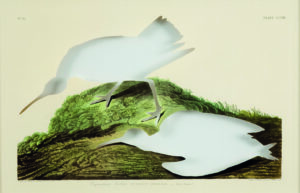Brandon BALLENGÉE: Frameworks of Absence: RIP Esquimaux Curlew, 1972/2007
Frameworks of Absence: RIP Esquimaux Curlew, 1972/2007
Brandon Ballengée (American, 1974 – )
2015.05.01 A & B

Altered Print Artist-cut and burnt chromolithograph “Esquimaux Curlew (Numenius borealis) No. 42, CCVIII” drawn by John James Audubon from the limited Amsterdam edition of Birds of America published by Johnson and Theatrum Orbis Terrarum, 1971-72.
The Eskimo curlew (Numenius borealis) was one of the most populous shorebirds in the tundras of western arctic Canada and Alaska. Extensive hunting, with approximately two million birds killed per year in the late 1800s, drove the species to extinction. The last sightings were 1962 in Galveston Island, Texas, and 1963 in Barbados.
Frameworks of Absence: The Extinct Birds of John James Audubon
We are in the middle of a mass extinction event. Referred to as the Holocene or Sixth Extinction, species are disappearing at upwards of a thousand times their natural rate. Hundreds, perhaps thousands, of animals have disappeared from the Americas in recent centuries. Such extinctions date to when the Europeans first colonized these new lands and have continued today with recent losses like the Eastern cougar (2013), the Pinta Island tortoise (2012), the Florida fairy shrimp (2011), and others.
Responding to this species loss, I physically cut images of such animals from historic prints and publications printed at the time in history when the depicted species became extinct. These original prints date from 1640 to 2014 reflecting the long term and continued loss of biodiversity. For example, in RIP Pied or Labrador Duck: After John James Audubon (1856/2007), the image of the birds was removed from an original 1856 Royal Octavo (hand-colored by one of Audubon’s sons) printed at the same point in history that the actual species disappeared. The resulting image-altered print placed between glass is what I refer to as a “Framework of Absence.”
I began in 2007 with ten prints from John James Audubon’s epic Birds of America.
The series is ongoing: I have now altered dozens of historic works, including such nonavian species as extinct mammals, fishes, insects, and others.
—Brandon Ballengée
2015